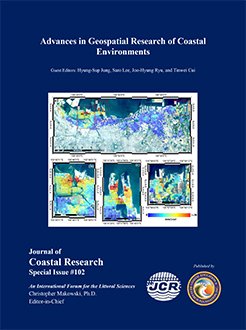Park, N.-W. and Jang, D.-H., 2020. Geostatistical classification of intertidal surface sediments using log-ratio transformation and high-resolution remote sensing imagery. In: Jung, H.-S.; Lee, S.; Ryu, J.-H., and Cui, T. (eds.), Advances in Geospatial Research of Coastal Environments. Journal of Coastal Research, Special Issue No. 102, pp. 157-165. Coconut Creek (Florida), ISSN 0749-0208.
This paper presents a multivariate geostatistical approach to classify intertidal surface sediments by combining compositional data analysis and high-resolution remote sensing imagery. An isometric log-ratio (ilr) transformation is first applied to the sediment composition data prior to employing geostatistical analysis to consider the compositional properties of the sediment compositions. To complement the information deficiency of sparse field measurements, high-resolution remote sensing imagery is considered as exhaustive soft information and integrated with the ilr transformed balances via simple kriging with varying local means (SKLM). An inverse ilr transformation is then applied to the SKLM results to obtain sediment compositions over the study area. Finally, Shepard's classification scheme is applied to the sediment compositions to classify the intertidal surface sediments. A case study was conducted on the Baramarae tidal flats in Korea with high-resolution KOMPSAT-2 imagery to demonstrate the effectiveness of the proposed geostatistical approach. The classification results produced by the integration of high-resolution remote sensing imagery via ilr transformation and SKLM outperformed those based on cokriging of sediment compositions, with an improvement of approximately 11.7 %p in overall accuracy. This improvement was attributed to the superior prediction capability of SKLM for sediment compositions. Further, detailed variations in the sediment distributions in the study area, which could not be observed when using only a limited number of sediment samples, could be revealed by integrating the high-resolution remote sensing imagery. Therefore, the geostatistical integration approach that properly accounts for both the property of sediment compositions and the exhaustive soft information from remote sensing imagery could be effectively applied for the classification of intertidal surface sediments.





